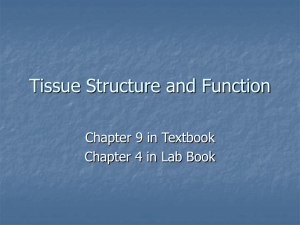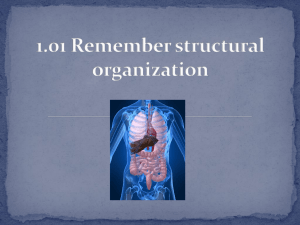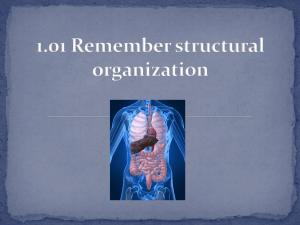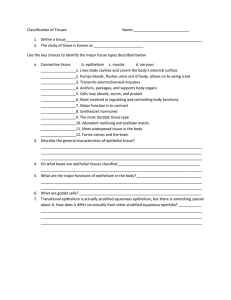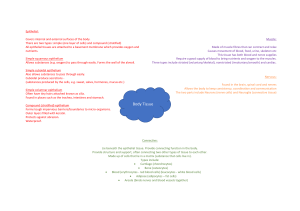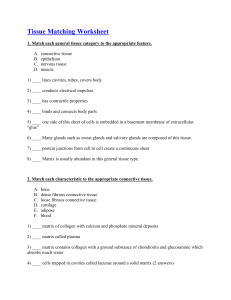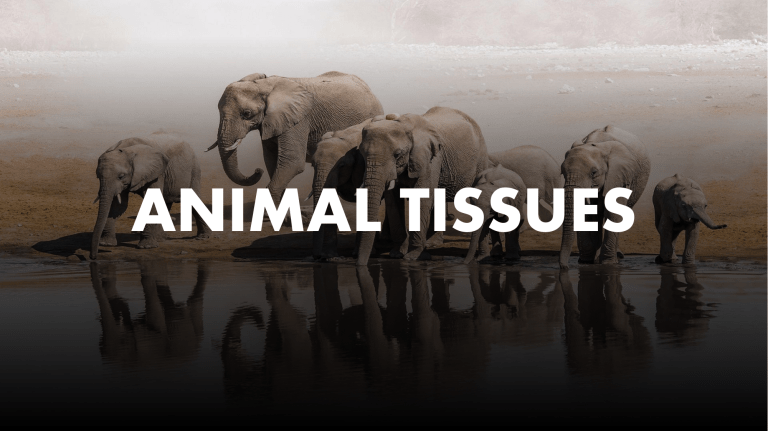
ANIMAL TISSUES LESSON OBJECTIVE Classify animal tissues and specify the function of each type. GENERAL CHARACTERISTICS OF ANIMALS • Multicellular (many-celled) • Eukaryotic (has distinct nucleus and membrane- bound organelles • Heterotrophic (produce their own food) • Motile (capable of movement or locomotion) • Reproduction (sexual and asexual) GENERAL CHARACTERISTICS OF EPITHELIAL TISSUE A. Found on a body surface either internal or external B. Tightly packed cells C. Free border or free surface D. Rest on a basement membrane E. Nonvascular FUNCTIONS OF THE EPITHELIAL TISSUE FILTRATION PROTECTION (exposed/internal surfaces from abrasion, dehydration, and destruction) ABSORPTION (every substances that leaves or enters must pass through the epithelium) SENSATION (large sensory nerve supply) (lining of small intestines absorbs nutrients into blood) SECRETIONS (different glands produce perspiration, oil, digestive enzymes and mucus) EPITHELIAL TISSUE Simple Squamous Stratified Squamous Columnar Epithelium Ciliated Columnar E. Cuboidal Epithelium Glandular Epithelium GENERAL CHARACTERISTICS OF MUSCULAR TISSUE A. Excitability (equated with responsiveness) B. Contractility (causes the fiber to shorten resulting in either pull on bones or the movement of specific body parts) GENERAL CHARACTERISTICS OF MUSCULAR TISSUE C. Elasticity (the muscle’s ability to return to its original length when tension is released D. Extensibility (capability of extending in length in response to the contraction) FUNCTIONS OF THE MUSCULAR TISSUE BODY MOVEMENT (requires skeletal muscles, bones, and joints to work together) HEAT PRODUCTION (a byproduct of friction caused by muscle tissue contracting) BODY STABILITY (requires skeletal muscle contractions to help maintain body positions) STORING AND MOVING SUBSTANCES (within the body require both smooth and cardiac muscle) MUSCULAR TISSUE Skeletal Muscle • Striated • Voluntary Smooth Muscle • Unstriated • Involuntary Cardiac Muscle • Striated • Involuntary GENERAL CHARACTERISTICS OF CONNECTIVE TISSUE A. Composed of cells which maybe single, in twos or in four and are usually enclosed within empty spaces called lacunae B. These cells are far apart, thus necessitating a larger amount of intercellular substance (matrix) between them GENERAL CHARACTERISTICS OF CONNECTIVE TISSUE A. The matrix is secreted by the cells and contains other substances which help strengthen the tissue, therefore function for support. B. It also contains fibers, elastic or collagenous substances that facilitates its binding and connection function. FUNCTIONS OF THE CONNECTIVE TISSUE FILLS UP SPACE (fills up spaces within or between organs like the areolar, subcutaneous tissue) SUPPORT AND CONNECTION (supports, surrounds and interconnect other types of tissue) TRANSPORT PROTECTION (transporting of fluids and dissolved materials through blood) (protection of delicate organs through cartilage and bone) ENERGY STORAGE DEFENSE MECHANISM (storing energy reserves in the form of triglycerides) (defends the body from invading microorganism) CONNECTIVE TISSUE Connective Tissue Proper • Areolar Tissue • Adipose Tissue • Fibrous Tissue Supportive Connective Tissue • Bone • Cartilage Fluid Connective Tissue • Blood • Lymph GENERAL CHARACTERISTICS OF NERVOUS TISSUE A. Specialized for the transmission of the impulses. B. Composed of neurons which are nerve cells with long processes or nerve fibers. C. Neuron is the functional unit of the nervous system D. Neurons live and function optimally for a lifetime


